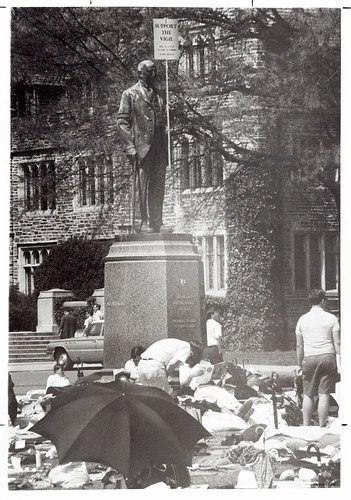
"James B. Duke Statue at the Vigil, 1968." Duke University Archives, Durham, NC. Retrieved April 2012 from: Duke Yearlook: Flickr. Online.
The Duke University Silent Vigil (April 5-11, 1968) is one of the more well-known acts of protest that has taken place on Duke’s campus. Incited by the assassination of Dr. Martin Luther King Jr., this peaceful protest evolved over a week of national mourning and was described at the time as the “first major attempt of students at a predominantly white university to respond to the life and death of Dr. King by confronting those who make decisions about society and its structures, and DEMAND A CHANGE” (3)*. Primary materials reveal that the Vigil’s visions went far beyond this original spark. Yet while this event continues to be memorialized on a fairly regular basis, details about how it was originally received by the administration and fellow students, what the campus atmosphere was like at this time, and exactly what the participants demanded have not always been accurately remembered. A close look through the Duke University Archives, along with firsthand accounts of participants, reveal a telling timeline of how events truly unfolded.
Timeline
- Thursday, April 4, 1968
- Dr. Martin Luther King Jr is assassinated in Memphis (evening)

Silent Vigil, 1968. Duke University Archives, Durham, NC. Retrieved April 2012 from: Duke Yearlook: Flickr. Online.
- Friday, April 5, 1968
- “Memorial Vigil”: Main Quad, West Campus at noon
- ASDU campaign election postponed
- Vigil announcements posted with list of demands
- “Memorial Procession for Dr. Martin Luther King”: 7pm on Main Quad
- ~450 students/faculty members march to President Knight’s house, present demands**
- “That he sign an advertisement mourning the death of Dr. King” in a local Durham newspaper
- “That he support a minimum wage of $1.60 for all Duke employees”
- That he support the “creation of a committee to suggest a suitable bargaining agent for Duke employees”
- “That he resign from the segregated Hope Valley Country Club” (“YESTERDAY EVENING…,” folder 3).
- 250 enter house
- 200+ spend two nights there
- President Knight, who engaged in peaceful discussion with the protestors, got tired after hours of discussion and asked them to stay
- Saturday, April 6
- Fast of Penitence related to both MLK assassination and Vietnam War
- 200+ remain at President Knight’s house
- Situation announced – flyers on campus
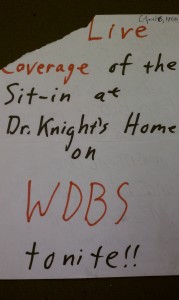
WDBS Poster, Duke Vigil Collection, Duke University Archives, David M. Rubenstein Rare Book & Manuscript Library, Durham, NC.
- Sunday, April 7
- Rally/sympathy march: 2pm from Main Quad
- Students and faculty announce that they will not attend class Monday/Tuesday out of respect for MLK
- Boycott of dining facilities to support the union/striking employees
- Negotiations with President Knight are postponed until 4pm Monday due to illness
- The Vigil is moved to the Main Quad
- Another goal is to get more students involved
- Posters emphasize non-violent action

Source: Boyarsky, Bill. From the Jack Preiss Collection. Accessed April 2012: Durham Civil Rights Heritage Project. Online.
- Monday, April 8
- 500 more people join Vigil
- Posters call for “CLASS BOYCOTT” through Tuesday (5).
- Knight authorizes 3rd&4th periods to be canceled Tuesday
- 4pm negotiations go nowhere
- Duke workers hold a strike meeting
- Vigil establishes ground rules
- Divinity School faculty offers to suspend 1968-1969 annual bonus to increase pay for non-academic employees
- Tuesday, April 9
- WDPS dorm polls reveal that support for Vigil is not unanimous among students
- Law school statement: “Their plea for support is a hopeful but a desperate one. Although their numbers have grown over the past few days to more than 1500 active participants, there has been a similar increase elsewhere of others who have waited too long for our institutions and our people to respond to the cries for social justice”(6).
- Inter-Fraternity Council (IFC) supports Vigil and 4 goals
- Theta Chi: opposes methods of protest but supports goal of racial justice
- Tau Epsilon Phi: supports all 4 points
- Memorial service for MLK at Duke Chapel
- Robert Cushman delivers speech
- Student leaders of Vigil submit statement
- Effort “to demonstrate that white America was concerned with the problems of the Black man”(6).
- White students and black employees/Durham residents join hand in hand at Vigil to sing “We Shall Overcome,” a popular song of Civil Rights protest at this time
- Dining hall workers continue to strike

Boyarsky, Bill. From the Jack Preiss Collection. Accessed April 2012: the Durham Civil Rights Heritage Project. Online.
- Wednesday, April 10
- Samuel Dubois Cook – one of the few African American faculty members at Duke at the time – addresses the Duke Vigil
- “I do not know if you fully realize the ultimate significance of what you are doing…. I have been involved in quite a few civil rights activities in my life, but I haven’t seen anything, anywhere comparable to this. You would expect…the victims of oppression to sacrifice, to take to the hot sun, to take the rain, to sleep at night in the open and cold air…. But you do not expect people born of privilege to undergo this kind of harsh treatment. This is one of the things I think will help to redeem this country and help to create the beloved community”(7).
- Discussion of progress held
- Statement to students by Wright Tisdale (President Knight ill)
- $1.15 is minimum wage for universities
- University agrees to augment minimum wage to $1.60 by July 1, 1969 with a significant step by July 1, 1968
- In favor of requested committee; its scope to be determined by President Knight upon return
- Other demands are to be addressed by President Knight
- Resolution adopted by Academic Council
- Continuing elevation of conditions for workers
- Urge everyone to return to class, attention to issues will continue
- No reprisal against non-academic employees
- Meeting minutes reveal perception among faculty/administration that Duke is in the midst of “days of tremendous crisis”(7).
- Concerns
- Lack of communication between administration and student leaders/council
- Academic freedom
- Impact on faculty of foregoing raises to increase minimum wage
- Disintegrating relations Durham administration/residents
- Some faculty members feel students “are hurting themselves” and that their ultimatum “smacks of fascism” (7, p.68-69).
- “These students are not the beardos and weirdos – these are the solid, clean Duke students that hoped sincerely that Mr. Knight would give an earnest of his intentions to agree to these request” (7, p.69).
- Regarding the Country Club request: “If everybody stayed away, Duke University would never be an integrated university” (7, p.70).
- Participants encourage continuing boycott
- Thursday, April 11
- Primary purpose of Vigil: that the university accept the legitimacy of collective bargaining
- Petition to Durham government to “address itself to alleviating the grievances of the Negro citizens of Durham”(8).
- Classes held on the quad
- Friday, April 12
- “The New University” appears in the Duke Chronicle, a new publication as of 1968
- Reflection on protest
- “Revolution must always be followed by re-evaluation…of ourselves, our individual relation to our society, our University and its power structure”(9).
- “…faculty literally awed…and strangely respectful of an element in the student body’s character which no one had known existed before“(9).
- Trustees originally unconcerned, learned a lesson
- “We must never return to that indifference”
- Divinity school faculty responded to Vigil more strongly and quickly than any other group
April 12th was the end of the Silent Vigil as it was traditionally known. Students moved off the Main Quad and enjoyed Joe College Weekend as they awaited the administration’s response to their demands. However, the action was far from over:
- May 1968
- Vigil reconvenes, not satisfied with administration’s progress
- May 10th: 1-day boycott
- Armbands worn at commencement to show continuing support for Vigil’s goals
- General disappointment with trustees
- September 19-21, 1968
- Black Days in Durham
- October, 1968
- Controversy: 2 Political Science professors thought to have been let go due to participation in Vigil
What became of the Silent Vigil of 1968?
The Silent Vigil was, at the time, a bit if a public relations crisis for Duke. Some outsiders thought the Vigil was foolish and the administration lacked fortitude. Even on campus, not all students and faculty were in favor of the Vigil; participants I interviewed recalled taunting and negative feedback from some peers. Nevertheless, the Vigil made an impact. Not only did it force Duke to take a hard look at its policies, it also revealed a side of Duke students that many were unaware existed. Pitted against more socially active campuses such as Columbia University, Duke students had previously been seen as white students from privileged backgrounds who had no stake in the Civil Rights Movement or the turbulent world developing outside their university walls. The Vigil, however, proved that there was in fact a sizable portion of Duke University students and faculty who not only cared, but who would put their health, safety, and academic record at risk to fight for justice. This truth went far beyond Durham limits as the event gained national attention; Senators Robert Kennedy and Eugene McCarthy even endorsed the idea.
The Silent Vigil proved that nonviolent action could enact change. In response to the events of April/May 1968, the Duke administration formed a “Duke University Nonacademic Employees Council,” members of which would be elected by nonacademic personnel. The Duke University Employee Relations Advisory Committee was also created. A timeline was set for raising the minimum wage, and $1.60 was promised by July 1, 1969. Today, nonacademic employees at Duke are unionized
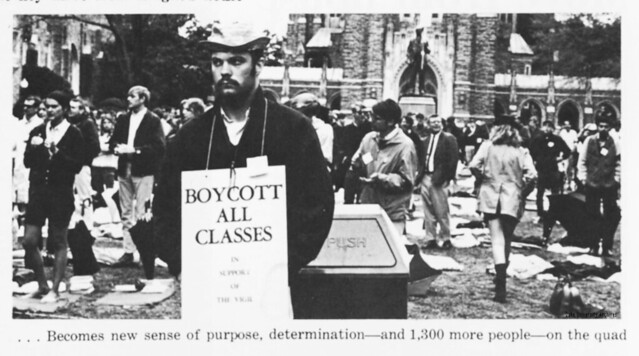
Student Tim West at the Vigil, Duke University Archives, Durham, NC. Retrieved April 2012 from: Duke Yearlook, Flickr. Online.

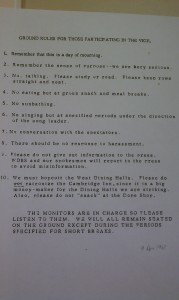
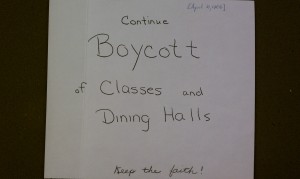
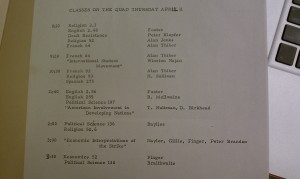
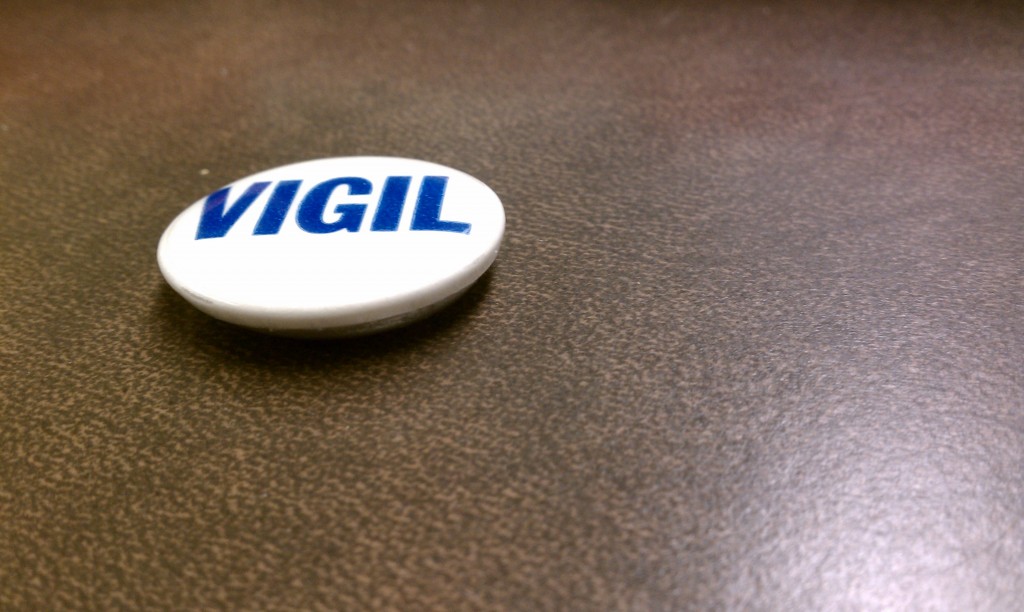
I was in the Doctoral program in Mathematics when MLK was assassinated, and joined the sit-in a day or two later. I never returned to class. I dropped out, joined the Peace Corps, came home and became a Conscientious Objector to the VietNam war, and worked 40 hours/week for two years in a “Free Clinic” in Seattle, while also working 40 hours/week in the “Morgue” of a daily newspaper. Ultimately I worked for two years as a journalist in New York City, and 25 years at IBM as a writer/editor and finally a webmaster.
The Duke Silent Vigil was one of the most powerful experiences in my life. I recall standing next to a camera crew from one of the major TV networks as they interviewed one of the strike leaders. At the end of the interview the reporter said “Well, I know we won’t use this footage, but if there’s any violence give me a call, here’s my card.”
I recall the silent response to Wright Tisdale when he addressed the Vigil, and walking silently single-file into a theater/auditorium nearby. The strike leaders disappeared behind the stage curtain to discuss how to respond. The theatre was packed, with students sitting in the aisles. Time dragged on, and people began to worry and whisper that the leaders were going to “Sell Out” – – that the “Four Non-Negotiable Demands” were going to be abandoned. When someone finally appeared onstage from behind the curtain, we all rose as one and started chanting “FOUR! FOUR! FOUR! FOUR! FOUR! . . . . ” I looked around and realized everyone had his/her right arm raised with four fingers extended in what looked eerily like a Nazi salute. It gave me goose pimples and the hair on the back of my head stand up. Two friends and I sat down, but the crowd continued the chant and the “salute”, and it dawned on my that a mob of well-meaning liberals could be just as scary and just as dangerous as any other mob.
Wow! Thank you so much for sharing your experience.
You’re welcome. I’m now retired and in a story-telling group in Olympia, WA. I’m pondering a story about my experiences with race relations, and was searching the web for details about The Stallion Club, a black night club in Durham that I used to go to. My memory says I heard Junior Walker and the All Stars, and BB King there, but I don’t trust my memory so I’m trying to find out if they really played there in 1967-68. This site came up during my search, and I was surprised to find my earlier post here. The Web is am amazing invention.
I had the same reaction as Carl to the “Four” salute. It was sobering.
Pingback: Rusty Wright: Lessons in Managing Public Speaking Fears – BCNN1 WP
Tom Rainey here. I was an assistant professor of history at Duke between 1967 and 1969. I am currently professor emeritus of Russian and Eurasian Studies at The Evergreen State College, Olympia, Washington. I am proud to say that I participated fully in the Duke Vigil. I have been engaged since in a number of struggles for racial equity and social justice. As a seventh generation Florida Cracker, I have struggled all of my life with the racism and bigotries that were taught to me by my loving family, mostly by example. As Bunny Small and I said in an article published by the North American Review in the Summer of 1969, that struggle for white folks, “Ain’t Ever Over.” I am currently writing something in the way of a memoir. I will call it A Cracker’s Progress.
Good to hear of you and your thoughts, Tom. I remember many conversations from those days.